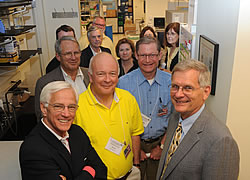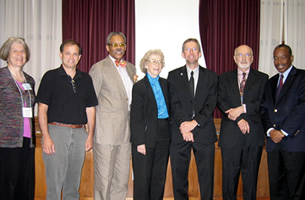Last updated: March 14, 2014
Science in the Court
Science in the Court
NHGRI Scientists Present Latest Genomic Advances to Visiting Judges
June 2010
 |
Titled Genomics, Medicine and Discrimination, the four-day program was created by the National Human Genome Research Institute (NHGRI) at the NIH, and the Advanced Science and Technology Adjudication Resource (ASTAR) Center, a judicial education entity affiliated with court systems, supported by the U.S. Department of Justice, and headquartered in Washington, D.C. The intensive course of lectures and tours at NIH spanned topics from genes and how they work, to the Genetic Information Nondiscrimination Act of 2008, which protects Americans against health insurance and employment discrimination based on their genetic information.
Intramural researchers and staff from NHGRI, as well as the National Cancer Institute, National Institute on Alcohol Abuse and Alcoholism, National Heart, Lung and Blood Institute and National Institute of Mental Health, shared the lectern with an array of legal and medical experts from around the country.
"The program provided an important forum for NIH scientists to convey basic genetic and genomic information to the judges and offer a perspective on how their research may impact the courts and society," said program co-organizer Vence L. Bonham, J.D., chief of the NHGRI Education and Community Involvement Branch. "We presented a range of information to enhance the judges' confidence to properly interpret the terms of reference when genomics-related issues arise in court and expert witnesses testify."
NIH is just one stop in a network of ASTAR programs for judges around the country that expose them to advances in science and technology, new terminology and the researchers themselves. ASTAR has collaborated previously with NIH institutes, including the National Institute on Alcohol Abuse and Alcoholism and the National Institute on Drug Abuse. Future ASTAR collaborations include the Eunice Kennedy Shriver National Institute of Child Health and Human Development.
ASTAR is funded by the U.S. Department of Justice, which is mandated by Congress to offer the science and technology resource judge program to all U.S. jurisdictions. Since 2006, the center has held regional science and technology boot-camps and has offered training to several hundred judges across the country. In turn, the judges become a resource for their colleagues on the bench. A judge who earns 120 hours of ASTAR education, learning the terms of reference of court-related science and technology evidence and issues, can become an ASTAR fellow.
 |
Court leaders attended from across the country - Hawaii on the west and Virginia in the east; Virgin Islands in the south and Minnesota in the north. Six chief justices of state supreme courts joined 20 associate justices and appellate court colleagues to learn about genomics. Additional participants included 30 ASTAR fellows, who are active trial and appellate judges tapped for science and technology information leadership in their home court systems. While predominantly an offering for state courts, two federal court leaders and two District of Columbia judges, a federal Article One court, also attended.
ASTAR trainees are selected by their jurisdictions and are awarded Department of Justice scholarships to attend ASTAR programs. Participating judges are required to pledge to remain on the Bench for five years following their science and technology training in return for their jurisdictions' provision of time off the Bench. "Our mission is to develop portals between court systems and science centers so that judges can be properly prepared case managers at trial and on appeal," ASTAR Director Franklin M. Zweig, Ph.D., J.D said. "ASTAR attempts to narrow the gap between explosive scientific discovery with associated rapid technology commercialization and the Judicial Branch's traditional, slower-moving, fair trial commitment to every citizen."
The program featured basic science applicable to civil and criminal court cases, and the presentation of actual legal cases. Hon. Lawton R. Nuss, Supreme Court of Kansas, particularly valued the presentation by employment lawyer Douglas Mishkin, J.D., who spoke about applications of the Genetic Information Nondiscrimination Act, and by two fellow judges about admissibility of evidence and expert witness qualifications. "These are some principles we can take and apply in our field."
Hon. Laura Denvir Stith, Supreme Court of Missouri, remarked that by the end of four days of training that she and her colleagues became much more comfortable with the scientific concepts introduced. "It was the most informative continuing learning education program I've been to since I became a judge," she said, adding that she was impressed by the presentations from nationally renowned scientists who could bridge the gap in presenting science to those trained in the law.
Ultimately, the six-month, joint effort by NHGRI and ASTAR sought to generate an understanding and awareness of the kinds of scientific resources available to the courts. "State and federal judges make decisions that apply science to the law that are important to all of us," said Mr. Bonham. "For them to learn more about science is valuable for courts across the country."